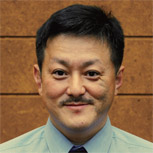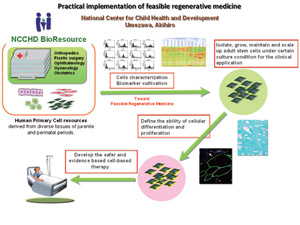HOME > Program Members > Akihiro Umezawa

Akihiro Umezawa

Director, Department of Reproductive Biology and Pathology, National Research Institute for Child Health and Development
Akihiro Umezawa, MD, PhD
umezawa@1985.jukuin.keio.ac.jp
http://www.nch.go.jp/reproduction/e/index.html
Theme
Neural stem cells (NSCs) possess the capability for self-renewal and are multipotent, that is, they can Nuclear reprogramming is the process by which developmental potential is restored to adult somatic nuclei. This process may be artificially induced by somatic cell nuclear transfer (SCNT), cell fusion and also now, viral transduction with four stem cell genes. Each of the three strategies can drive a pluripotent stem cell, which can maintain self-renewal and develop into any type of tissues or cells in the body. These strategies could provide a potentially endless source of cells for biological research as well as medical applications, toxicity assessment, drug testing and possibly even gene therapy. Our main project is to explore the fundamental reprogramming and to develop the clinical application embyo-stem (ES) cells through SCNT. The ES cells produced by SCNT retained their self-renewal and pluripotent capabilities, contributing to all germ cell layers. Gene expression profiling experiments showed that the ES cell lines derived from NT and fertilized mouse blastocysts were indistinguishable. Today, NT remains the tool of choice for studying reprogramming at a functional level, while? more amenable approaches may be helpful for dissecting reprogramming at the cellular, molecular and biological levels. We are involved in the study of the SCNT-ES cell model for widespread applications in the fields of developmental biology, cell-based therapy and drug development.
Research activities
Search for nuclear reprogramming through SCNT
We have addressed the molecular mechanism of genetic and epigenetic reprogramming for X chromosome inactivation (Eggan, Akutsu, et al. Science), imprinting gene expression (Humpherys, Akutsu, et al. Science), and pluripotent gene characterizing (Bortvin, Akutsu, et al. Development). We have also reviewed the scientific research addressing nuclear reprogramming (Sullivan, Umezawa, and Akutsu. Reprod Biol Online).
Derivation for clinical-based ES cells and xeno-free culturing system
We have developed humanized culture conditions for ES cells, and started the human ES cell derivation project. The Minister of Education,Culture,Sports,Science and Technology authorized our undertaking of the human ES cell derivation. Our human ES cell derivation project is the second to receive a license throughout the nation.
Developing application of human mesenchymal stem cells for regenerative medicine
We have built human primary cell resources ("NCCHD Bio-resource"), derived from diverse tissues from the juvenile and perinatal periods, and also a clinical research system capable of responding appropriately to future medical applications utilizing the NCCHD Bio-resource. We have also explored their molecular characteristics (Seco, Umezawa, et al. PLoS One) and differentiation ability (Kami, Umezawa, et al. PLoS One).

Fig.1 Validation system of the stem cells for regenerative medicine
Selected Paper
- Kami D, Shiojima I, Makino H, Matsumoto K, Takahashi Y, Ishii R, Naito AT, Toyoda M, Saito H, Watanabe M, Komuro I, Umezawa A. Gremlin enhances the determined path to cardiomyogenesis. PLoS ONE.2008;3(6):e2407.
- Zhu W, Shiojima I, Ito Y, Li Z, Ikeda H, Yoshida M, Naito AT, Nishi J, Ueno H, Umezawa A, Minamino T, Nagai T, Kikuchi A, Asashima M, Komuro I. GFBP-4 is an inhibitor of canonical Wnt signalling required for cardiogenesis. Nature.2008;454(7202):345-349.
- Hida N, Nishiyama N, Miyoshi S, Kira S, Segawa K, Uyama T, Mori T, Miyado K, Ikegami Y, Cui C, Kiyono T, Kyo S, Shimizu T, Okano T, Sakamoto M, Ogawa S, Umezawa A. Novel cardiac precursor-like cells from human menstrual blood-derived mesenchymal cells. Stem Cells.2008;26(7):1695-1704.
- Cui C, Uyama T, Miyado K, Terai M, Kyo S, Kiyono T, and Umezawa A, Human dystrophin expression in the mdx mouse, a model of Duchenne muscular dystrophy, can be conferred predominantly by "cell fusion" with human menstrual blood-derived cells Mol. Biol. Cell,2007;18(5):1586-1594.
- Sullivan S, Ichida JK, Umezawa A, Akutsu H. Nuclear reprogramming and the control of differentiation in mammalian embryos. Elucidating nuclear reprogramming mechanisms: taking a synergistic approach. Reprod Biomed Online. 2007;
Copyright © Keio University. All rights reserved.
